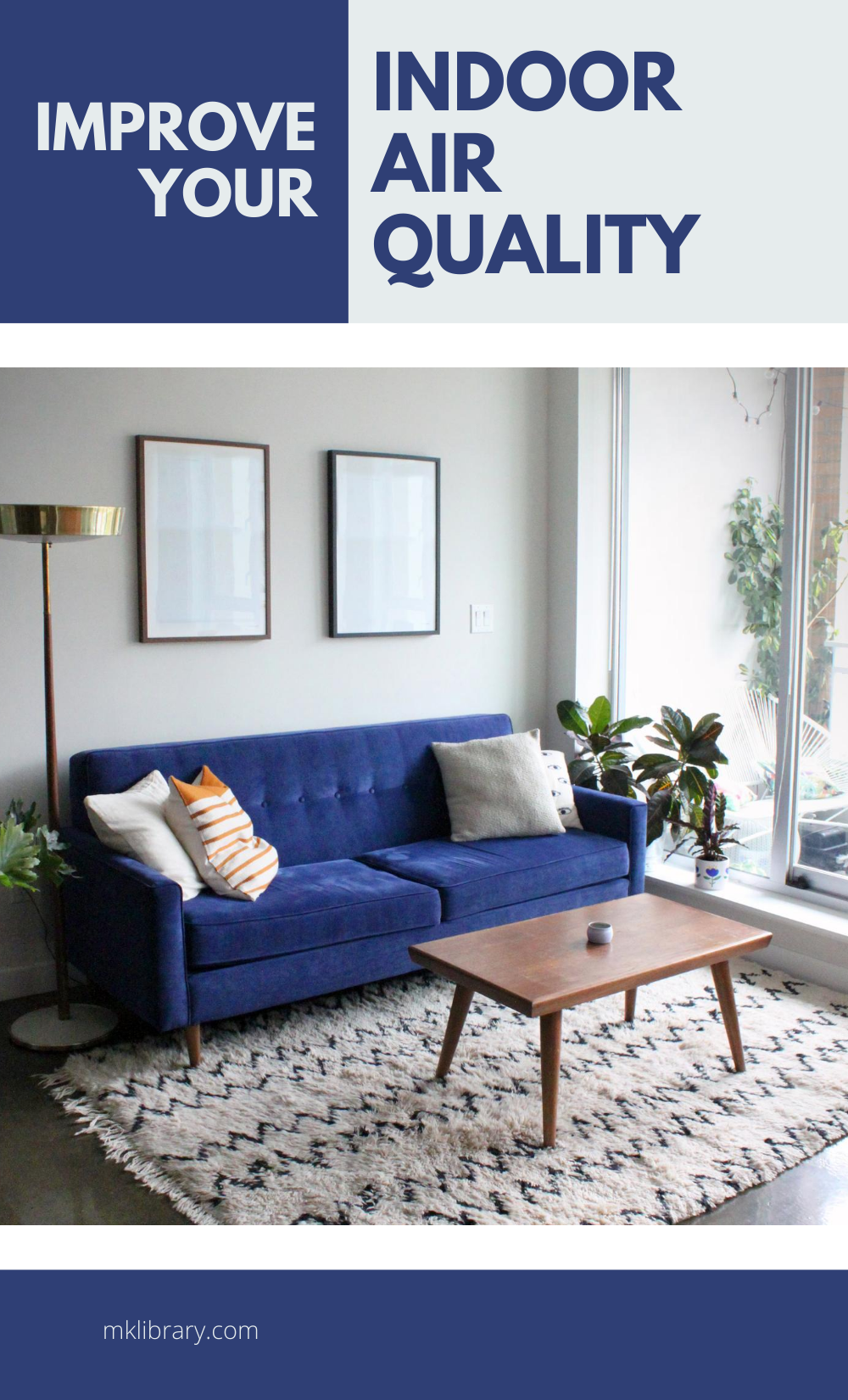Learn how to improve indoor air quality in your home safely and easily. Whether you live in a polluted city or suffer from the smoke of wildfires, this guide will help improve your quality of life and air quality at home. There is no smell like home!

This was originally written in mid-August, where California suffers from extensive wildfires. Despite being miles away, ash falls from orange skies and air quality alerts (AQI) prompt decisive action.
Table of Contents
Long term exposure to particulate matter and pollutants in the air in your home can have devastating long term effects.
- Premature death in people with heart or lung disease.
- Nonfatal heart attacks.
- Irregular heartbeat.
- Aggravated asthma.
- Decreased lung function.
- Increased respiratory symptoms, such as irritation of the airways, coughing or difficulty breathing.
Temporary symptoms of particle exposure can give you hints that your air quality is less than ideal.
- Irritation of the eyes, nose, and throat.
- Coughing.
- Phlegm.
- Chest tightness.
- Shortness of breath.
Types of Air Pollutants

There are seven main types of pollutants found in your home which affect the air you breathe.
Ozone. Ground level ozone is produced from the emissions from vehicles, power plants, industrial boilers, and other fossil fuel burning facilities react with sunlight. Every year, ozone causes more than 4,000 emergency room visits in New York City Alone.
Particulate matter. These are small particles, both in a solid and liquid form, which enter the lungs and cause respiratory problems. Particulate matter between 2.5 and 10 micrometers, also known as PM10, is created by crushing and grinding of materials, as well as dust on roads. PM2.5 is created by power plants, forest fires, and other forms of combustion. It can even come from the ammonia of fertilizer.
Formaldehyde. Often arising from new furniture including mattresses, formaldehyde causes nasal and eye irritation, eczema, and changes in lung function.
Benzene. Sweet smelling and highly flammable, benzene most often comes from tobacco smoke, vapes, electronic cigarettes, auto service stations, exhaust from vehicles, and industrial emissions. Sources found in your home can also include glues, paints, furniture wax, and detergent. Long term exposure causes cancer of blood forming organs and leukemia. Short term exposure has a myriad of symptoms, from drowsiness, dizziness, irregular heartbeat, headaches, tremors, confusion, and unconsciousness.
Carbon monoxide. One of the better known pollutants, carbon monoxide comes from vehicles, wildfires, and industrial combustion.
Sulfur dioxide. When coal and oil fuels are burned which contain sulfur, they create sulfur dioxide. The pollutants also contribute to other particulates forming.
Nitrogen dioxide. This chemical compound is created by road traffic and the combustion of other fossil fuels. Much like sulfur dioxide, the inclusion of nitrogen dioxide contributes to increased formations of other air pollutants.
SOx. The oxides of sulfur, both a federal and state standard of pollutants, which can include SO2, SO3, SO4, is an overarching term and type of pollution. Metrics including SO2/NOx are included on some sources on pollution, however these metrics are used more for industrial applications and not so much in the home.
People who have the highest risk of being impacted by these different types of air pollutants include:
- People with heart or lung diseases because they will feel the effects of particulate matter sooner and at lower ozone levels than less-sensitive people.
- Older adults because they may not know they have lung or heart disease. When particle levels are high, older adults are more likely than young adults to have to go to the hospital or die because the exposure to particle pollution has made their heart or lung disease worse.
- Children because they are still growing and spend more time at high activity levels. When children come in contact with particle pollution over a long period of time they may have problems as their lungs and airways are developing. This exposure may put them at risk for lowered lung function and other respiratory problems later in life. Children are more likely than adults to have asthma and other respiratory problems that can worsen when particle pollution is high.
- Infants because their lungs continue to develop after birth and can be impacted by air pollutants.
Source 1 | Source 2 | Source 3
| Daily AQI Color | Levels of Concern | Values of Index | Description of Air Quality |
|---|---|---|---|
| Green | Good | 0 to 50 | Air quality is satisfactory, and air pollution poses little or no risk. |
| Yellow | Moderate | 51 to 100 | Air quality is acceptable. However, there may be a risk for some people, particularly those who are unusually sensitive to air pollution. |
| Orange | Unhealthy for Sensitive Groups | 101 to 150 | Members of sensitive groups may experience health effects. The general public is less likely to be affected. |
| Red | Unhealthy | 151 to 200 | Some members of the general public may experience health effects; members of sensitive groups may experience more serious health effects. |
| Purple | Very Unhealthy | 201 to 300 | Health alert: The risk of health effects is increased for everyone. |
| Maroon | Hazardous | 301 and higher | Health warning of emergency conditions: everyone is more likely to be affected. |
Check the Air Quality Around You
On the day I wrote this, air quality varied from the 70s to over 150, based on time of day, all from California wildfires. The EPA has a map of air quality which allows you to see the particulate matter levels across the United States.
https://gispub.epa.gov/airnow/
For a map of smoke and fire, Air Now has a map that reports particle matter between 2.5 and 10.
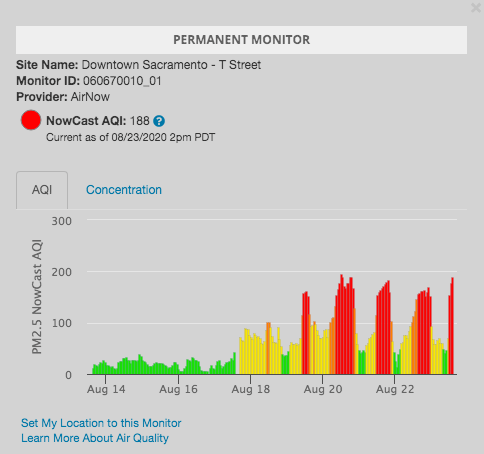
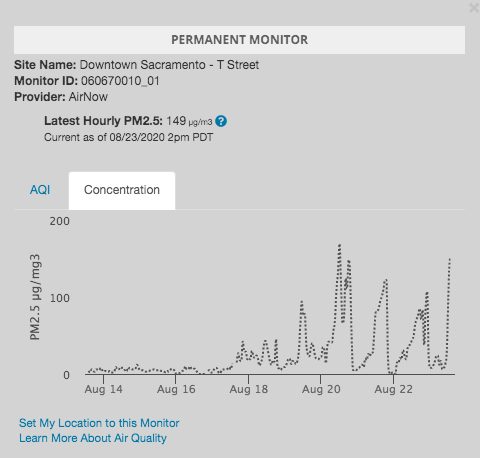
Easy Things You Can Do Right Now to Improve Your Air Quality
- Don’t smoke in your home.
- Avoid using any type of aerosol spray in your house.
- Conserve electricity and set your thermostat to a higher temperature.
- Vacuum and dust frequently.
- Use household chemicals in ways that minimize evaporation.
- Reduce or eliminate fireplace and wood stove use.
- Avoid using gas-powered garden equipment.
- Properly seal cleaners, paints, and other chemicals when done using to prevent evaporation.
- Use environmentally safe cleaning products and paint whenever possible.
How To Improve Indoor Air Quality

There are multiple layers in improving the indoor air quality, with each layer having a different impact depending on your current living situation.
- HVAC filters
- Door and window seals
- Air purifiers
- HEPA rated solutions
Change Your Air Filters
Regularly changing your air filter will go a long way in filtering the air in your home and improving air quality.
Set your furnace or HVAC to recirculate with just the fan running, without the heater or cooling to filter air. Run for about 15 minutes 3 times per day when other functions are not in use. Many modern systems will be able to run the fan independently at a lower speed for this simple function.
The best filter most commonly recommended by HVAC professionals is to use the cheapest generic ones for your system. This allows the greatest amount of air flow without adding stress to your HVAC.
However, for the sake of improving air quality and removing pollutants from the air in your home, you will need to choose an appropriate filter to accomplish this goal. There are two types of filters to choose from.
You may also want to read the home maintenance checklist for more things to check in your house.
HEPA and MERV Furnace Filters
HEPA filters are considered the best when it comes to removing particles from the air. However, you must make sure your HVAC system is rated to use a HEPA filter or you will end up overworking the motor and shortening the lifespan of a very expensive appliance.
The EPA did put together a study in 2018 and declared a MERV rating of 13 and above is necessary to properly cleaning your air.
MERV 11 filters must achieve at least 20 percent removal efficiency for 0.3–1 μm particles, while only MERV 13 and above require at least 50 percent removal efficiency for 0.3–1 μm particles.
MERV 16 is the equivilent of a HEPA filter. Nordic Pure has a pretty handy chart visually explaining the different ratings.
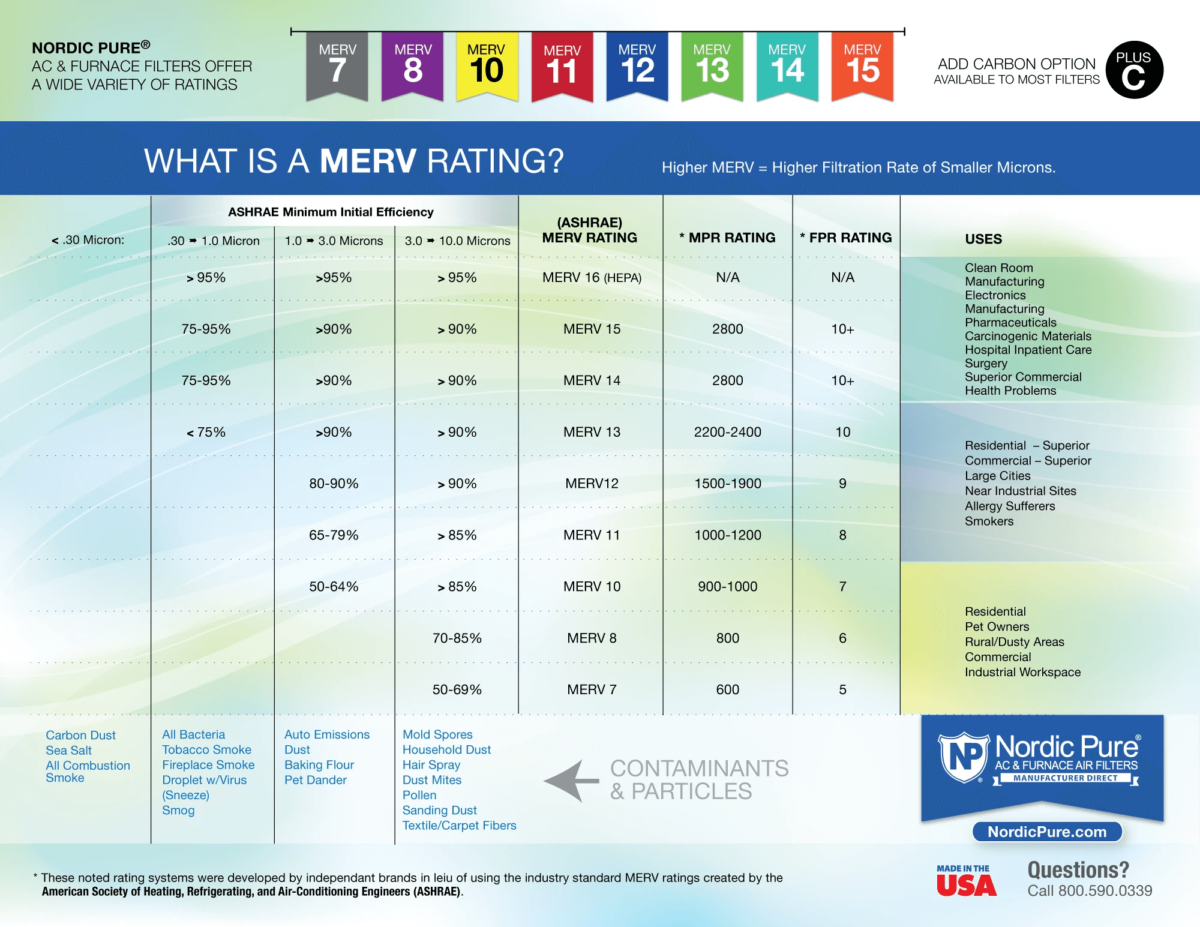
Upgrade your air filters with one of these options:
[amazon box=”B07FNXS7G9,B0073F2BWU” grid=”2″ button=”none” link_icon=”none” price=”none”]
For normal everyday use, I’ve gone with the Filtrete basic filters. When I have needed to run the furnace to filter out pollution and allergens, I switch to Nordic Pure. They certainly have a price premium to them, so if you don’t need to run the MERV 11-13+ filters year around, I recommend keeping the box and switching them out as needed.
One HVAC professional offered this advice on choosing the maximum MERV filter your furnace can handle:
A 2000 ft.² home might require airflow volume of around 1800 CFM.
You will usually need at least two very large filter rack areas to keep the static pressure down to 0.5 inches of water column.
You can never have too much filter area because you want to keep the airflow velocity feet per minute through the filter as low as possible because as the filters load the velocity will increase as will the static pressure.
The pleated filters load on the surface of the filter and therefore they load faster than a deep media filter resulting in increased velocity through the filter.
Of course a Merv-7 filter has considerable surface area and therefore if the area of the filter rack is of sufficient size it will take them a considerable time to load up.
A medium efficiency filter, rated at Merv-7, with the features of economy extended surface ‘pleated’ filter, dimensions of 24 x 24 x 4″ deep at 300 ft./m velocity through the filter, air will flow 1200 CFM at 0.13 inches of water column drop, the product chart says it will flow 2000 CFM at 500 ft./m at 0.22 inches of pressure drop.
This HVAC professional goes on to recommend one final thought: MERV-6 filters are sufficient to keep the furnace filters clean, and beyond that due diligence on what your furnace is rated for is recommended. Beyond that, if you aren’t sure, using a HEPA air purifier is recommended.
So what if you want to put HEPA filters in your furnace? In my research process and asking around, multiple HVAC professionals have recommended using a separate HEPA filtration unit. This is to keep your furnace functioning as efficiently as possible and not shortening the lifespan.
Most residential furnaces will simply not have sufficient HEPA capabilities, even if they say so. Furnaces with built-in HEPA functionality are usually found in high-tech and medical commercial facilities.
Eliminate Air Leaks in Your Windows and Doors
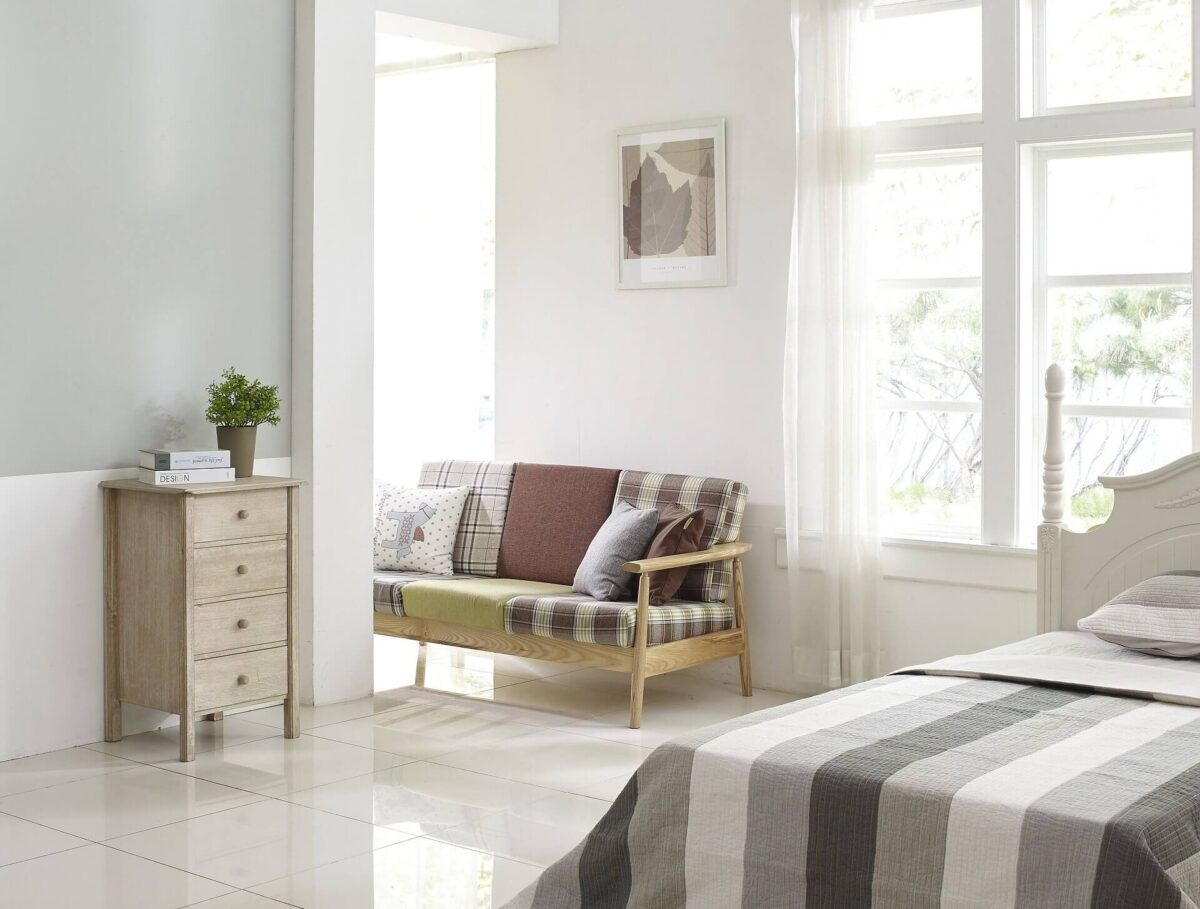
Sealing the airflow inside your home by removing air leaks will help your interior efforts at filtering and purifying air successful. Caulking and weatherstripping are going to be the easiest, most cost-effective ways to eliminate leaks due to small gaps and cracks around the framing.
These are some example products you will want to get. For weather stripping kits and the threshold, measure the gaps on the door and get an appropriate size as there are multiple options available. Select a color that matches and blends in.
Review the foam seal tape thickness and measure with your door gaps to make sure you don’t install too thick of tape. Otherwise, you will have a lot of trouble closing your door. It should be snug.
On caulking, you’ll want either white or clear, depending on your windows and exterior colors. Make sure whichever you chose is paintable and rated for exterior use.
With your home properly sealed from outside air getting in when it shouldn’t, your HVAC system or air purifiers will be able to better circulate air throughout your home.
An added bonus from sealing up air leaks is your home will also benefit from better energy efficiency and lower utility bills.
Vacuum with a HEPA Rated Appliance
When you are vacuuming your house, running a vacuum which uses HEPA filters will stop dust, pollen, and other contaminants from recirculating in the air.
[amazon box=”B07S864GPW,B0849Q3T3V,B07KCJZ31R” template=”list” grid=”1″ description=”none” button=”none” link_icon=”none”]
These are my three favorite vacuums out there today with exceptional cleaning and filtering capabilities. I use both the Shark IQ robot vacuum and the Sebo upright in my home. You can check out my experiences with the Shark on my Instagram. The Sebo has been a steady workhorse for over 9 years now.
Go through your house and dust all surfaces, nooks, and crannies before you run your HEPA filtered vacuum. Some commonly missed areas are baseboards, air vents, and atop the fridge.
For you DIYers out there, make sure your wet/dry vacuum is one which uses HEPA filters as well.
[amazon box=”B08CMS1YWV,B002MUAGEQ,B007ULBA4W” grid=”3″ button=”none” link_icon=”none”]
Vacmaster makes some of the most reasonably priced wet/dry vacs which can take HEPA filters.
Best Indoor Plants for Air Quality
There seems to be a very pervasive myth about plants and their positive effects on indoor air quality. As it turns out, don’t believe what you read on some random blog. Ahem.
It all stems back (pun intended, thank you very much) to an Associated Landscape Contractors of America and NASA funded report from 1989 (How to Grow Fresh Air: 50 Houseplants That Purify Your Home or Office), which as it turns out, has been replaced with updated studies, but the widely circulated original information has become an old wives tale.
The Atlantic has one of the best explanations of the truth behind the myths of houseplants cleaning the air.
Houseplants do not clean the air any more than an old pair of socks or baseball cap that I would hang on the wall.
Imagine a small office, 10 feet by 10 feet by eight feet. You would have to put 1,000 plants in that office to have the same air-cleaning capacity of just changing over the air once per hour, which is the typical air-exchange rate in an office ventilation system. Even if you chose the most effective type of VOC-filtering plant, you would still need one plant per square foot.
If you’re looking for something a little more data driven with plenty of citations, this Nature article from 2019 will provide ample detailed information behind the science.
As it also turns out, plants can have a negative effect on air quality.
Plants produce hydrocarbons or VOCs and can add different types of allergens to the air. One of these is called green leaf volatiles, or GLVs. A common one is
The plant VOCs mix with NOx and end up creating ozone in your home.
You could go so far as to say the best indoor plants for air quality are the ones which release the least amount of hydrocarbons.
For the sake of air quality, plants in your home are not ideal. However, from the perspective of quality of life and the psychological enjoyment of plants, and their ability to convert carbon dioxide to oxygen in your home, fill your home will all the plants of whatever type your heart desires.
Pin this!
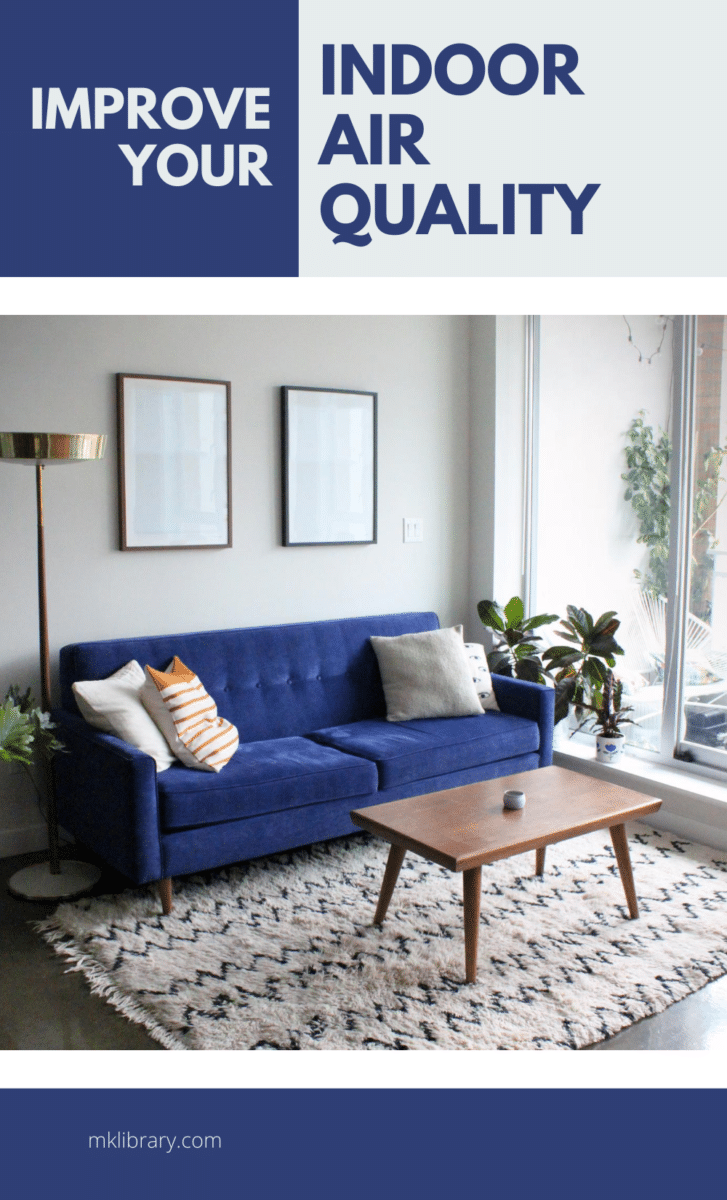
- About the Author
- Latest Posts
I strive to paint vivid landscapes with my words, bringing the magic of far-off lands and enchanting aromas to life for my readers. Combine passion for exploration and the art of gastronomy in an unending ode to the senses. When I’m not traversing the globe, I find solace in the earth beneath my fingertips, tending to my garden and working on projects around my verdant oasis. MK Library serves as a beacon, guiding fellow travelers and homebodies alike to embrace sustainability, nurturing both our planet and our souls with purpose. Full Bio.

